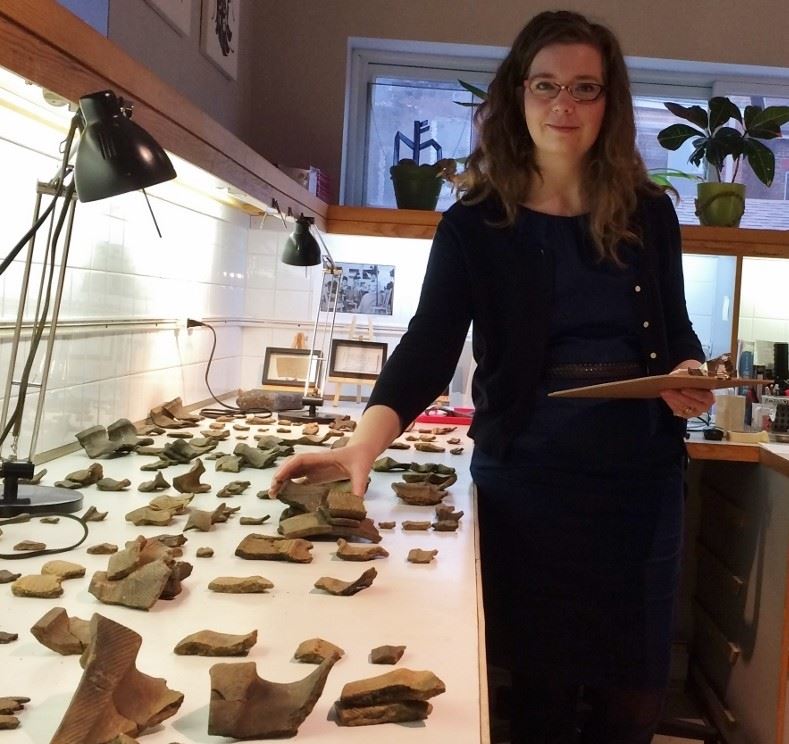Welcome to the installment of our Connections and Pathways blog series. This time we’re interviewing Caitlin Coleman, an Ontario archaeologist who works at ASI Archaeological and Cultural Heritage Services in Toronto! If you'd be willing to be interviewed for a future post, please contact Megan Anne Conger at megan.conger25@uga.edu. We'd love to hear from you!
1- First, thank you so much for participating in this! Please tell us your name, who you are, and how you’re involved in Ontario archaeology.
Thanks for asking me! My name is Caitlin Coleman, and I am the Assistant Manager of Communications and the Acting Lab Manager at ASI, the largest archaeological and cultural heritage consulting firm in Ontario.
2- Describe your own pathway to becoming involved in Ontario archaeology. How or why do you feel connected with Ontario’s past?
I did my undergrad in history and archaeology at McGill University, where I gained an interest in historical archeology and food history. I wanted my career to involve public outreach, so I next pursued a master’s of museum studies from the University of Toronto. After I graduated, I started working at ASI as a lab technician, and from there I was able to work my way up to assistant lab manager. In 2016 I took over the communications role, which I have really enjoyed! I now manage the internal and external communications at ASI, including our social media.
Because of social media, I feel connected to the larger conversations that are taking place within the archaeological world about everything from exciting new discoveries to our shared challenges. I also feel connected to Ontario’s past because I am lucky enough to work in an archaeology lab where I get to see artifacts come in fresh from the field from historical and indigenous sites across the province!
3- The theme of this year’s OAS symposium is “Connections and Pathways through the Past”. The organizers have highlighted a number of interesting connections that warrant exploration— “between the past and present, regional centers, archaeologists and the public, archaeology and history, Canada and the United States”. Are any of these connections especially important to you? How?
The connection between archaeologists and the public is the one I consider most often, due to my communications role. There is a certain segment of the public that is deeply interested in all new archaeological projects and news. For example, we connect with a lot of OAS members on social media. I try to remember that as comfortable as it is to communicate primarily with our colleagues, as archaeologists it is our responsibility to disseminate the knowledge we have gained as widely as possible. Most Ontarians don’t realize that archaeology takes place in their province, and that is an audience we need to reach! Cultural memory can be pretty short, and we are in real danger of the public losing touch with the people and lifeways that were here before.
4- We’ve invited a lot of reflection on the past, but it’s hard not to consider the future of Ontario archaeology as well. Is there any one question about Ontario’s past you’d love to have answered in the future? Or any one theme you think needs more exploration?
In archaeology, we often get excited about new discoveries and new excavations, but there is so much still to learn from legacy collections! I would love to see a movement towards revisiting older collections, questioning some of the conclusions that we have come to in the past, and rethinking past sites in the context of newer discoveries.
5- We’re ending every interview with a question provided by the last person we featured. Our last interviewee, Lisa Small, asked: “The archaeology of Ontario is an archaeology that considers diverse histories and retellings of the province’s multicultural past. That being said, how can archaeology in Ontario be used to promote and acknowledge these alternative understandings of the past that extend beyond normative narratives of Ontario’s history? “
I think that archaeology is essentially democratic. We learn about all types of people through our archaeological digs, whether rich or poor, well-established or recent immigrants. In a historical context, archaeology helps us fill in information about people who have fewer written records to trace their stories. I think that as archaeologists, we need to collaborate more with historians, museums, popular writers, and documentary film makers. Too often the diverse stories we uncover are placed into site reports or academic articles that are less accessible for people outside our discipline. Its so important that the stories we uncover get shared and spread wide!
6- Finally: What question do you want us to ask our next interviewee? It doesn’t have to be related to the theme of connections and pathways, but should be related to Ontario archaeology in some way.
I’m going to ask a fun one- what’s the craziest thing that has ever happened to you on site?
Thanks, Caitlin! Readers, if you liked this post and would be willing to be interviewed for a future entry, please contact Megan Anne Conger at megan.conger25@uga.edu. We'd love to hear from you!